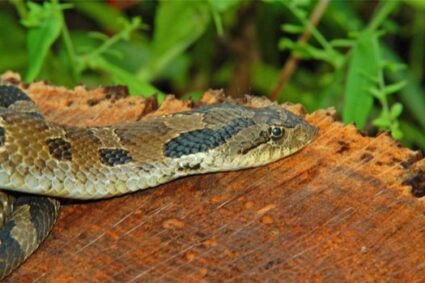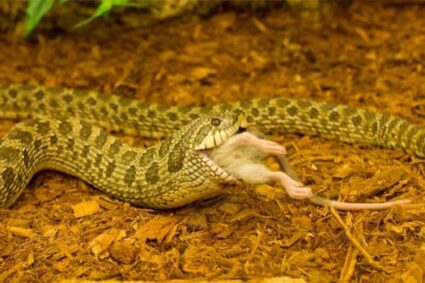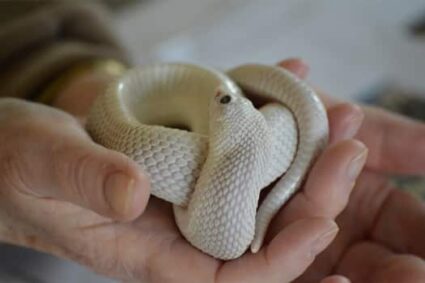Hognose snakes are a member of the Colubrid family. They are small compared to other pet snakes. The average adult is around 3 feet long. On average, hognose snakes weigh under 2 pounds. Males tend to be smaller than females, but it’s easy to care for pet hognose snakes in captivity.
Hognose snakes make calm, docile pets. They thrive in a warm tank with plenty of substrate to burrow in. You can feed your hognose snake a diet of pre-thawed frozen rodents. These snakes do not get sick often and are easy to look after.
Hognose snakes include 3 species within the genus Heterodon. These include the eastern hognose snake Heterodon platirhinos, the western hognose snake Heterodon nasicus, and the southern hognose snake Heterodon simus. While scientifically speaking these are 3 different species, all hognose snakes require basically the same kind of care.
How To Care for a Hognose Snake
Hognose snakes got their name from the upturned appearance of their snout. They use this snout to dig and burrow in loose soils and sand. It also helps them to hunt for prey in the wild.
What Tank Do Hognose Snakes Need?
Due to their relatively small size, hognose snakes can easily be housed in a basic terrarium you will find in a pet store. A hognose snake of average size will be contented with a 20-gallon or 30-gallon terrarium. A hatchling, on the other hand, will only need a 5-gallon tank.
A glass terrarium or a plastic cage will do nicely. If you choose a cage, look for one that is around 2 feet wide to give your snake enough floor space to explore. Height is not an important factor because they aren’t arboreal, preferring to live on the ground than in trees.
What Should You Put Inside The Tank?
A hognose snake’s new home needs a substrate to line its tank or cage. As mentioned, hognose snakes love to burrow and dig. In the wild, they use their upturned snout to dig through dirt and leaves to find their prey.
Your hognose snake will be happiest if you give it plenty of substrate to burrow in. Aspen shavings and Cypress Mulch provide excellent bedding, but newspaper or other recycled paper products work well, too.
You can make your hognose snake feel more comfortable in its new home by giving it some handy hiding places to crawl around and under. Hides, like little caves and logs, can be found at any pet store. You can also create your own hides at home out of old plastic containers and boxes.
While hognose snakes spend most of their time in or on the ground, they sometimes enjoy climbing. To give your snake a little variety in its routine, put some climbing furniture such as branches inside its cage.
Keep an eye on your hognose snake to see if it uses the branches for a new perspective. If it seems wary of the branch, feel free to remove it again.

How Warm Should The Tank Be?
Like other snakes, hognose snakes are ectotherms. This means that they cannot warm their own bodies internally as mammals do, and so they need their environment to provide them with warmth.
Hognose snakes will thrive in a habitat ranging between 75 and 85 degrees Fahrenheit. At night, it is alright if the cage goes down a few degrees in temperature just as it would in the wild.
You can heat your snake’s cage using a heat mat or other heat tape product placed beneath the cage. You can also place a heat lamp on top of the tank’s screen lid, which will provide warmth and lighting.
Be sure to regularly check the temperature of your snake’s tank. While it can be easy to see if a heat lamp burns out and is no longer working, it is harder to tell if a heat pad under the tank has gone cold. An adhesive thermometer placed inside the cage can make this an easy task.
Humidity Settings
Western hognoses don’t need their environment to be particularly humid. Keep the humidity between 30% and 50% for western hognoses, and between 50% and 60% for eastern and southern hognoses.
Lighting the Tank
Hognose snakes do not necessarily require lighting. However, to keep your snake at a maximum level of comfort, it is good to give it a natural day/night cycle of light as it would receive in the wild. Around 10 hours of full-spectrum ultraviolet lighting is healthy for your hognose snake.
Cleaning the Tank
Be sure to completely clean your pet hognose snake’s cage or tank a minimum of once per month. Here are some steps to follow:
- Remove all the substrate from the tank or cage
- Wash all of the furniture, including hides or climbing branches, with hot water and soap.
- Use an antibacterial cleaner that is safe to use around reptiles, and spray and wipe down the inside walls, floor, and ceiling of the cage.
Aside from this monthly intensive cleaning, be sure to spot clean the cage whenever you need to. After your hognose snake sheds, remove the old skin. Whenever your snake defecates, clean up the poop right away.
Sterilize your snake’s water bowl at least once a week. If your snake defecates or urinates inside the water bowl, clean the bowl out right away.
Make Sure The Snake Cannot Escape
Like many other snakes, hognose snakes love to test boundaries, especially when they first arrive in a new home. Be sure that your cage or tank is completely escape-proof before you put your new snake inside.
The hognose snake will explore all around the perimeter of the tank, and it will reach up the sides as far as it can as well, climbing on any furniture you have placed inside. All the snake needs to escape is a hole or crack as large as its skull. That is enough for it to escape.
If your terrarium has a screen lid on top, make sure that the lid is securely fastened. Clamps are a good way to keep the lid tightly on. It is also a good idea to have a lid that snaps into place or slides into a secure groove. A lid that just sits on top of the cage can be pushed aside by an inquisitive snake.
If you are using a cage that has a sliding door, make sure that the gap between the doors is too small for a hognose snake to squeeze through.
What Do Hognose Snakes Eat?
In the wild, hognose snakes usually eat toads or other small amphibian prey. They will also often eat reptile eggs, if they can find them.
However, it can be difficult to purchase toads in bulk at a pet store. Fortunately, hognose snakes can be taught to eat rodents instead.
How Often Should You Feed the Hognose Snake?
These snakes are eager eaters. They might even approach you with their mouth already open for a meal.
Hognose snakes only need to eat about once each week. New hatchlings will need to be fed a little more frequently than once per week. Full-grown adult hognose snakes may only need to be fed once every 10 days instead.
Consider the size of the meal you are offering when you decide how often to feed your hognose snake. A single appropriately-sized rodent is enough to feed a hognose snake once every 7 days. An appropriate size is a rodent which is about the same width as the thickest part of your snake’s body. Smaller meals can be provided more frequently.
Be careful not to feed your snake too often, or to feed them food that is too large. This can be difficult for the snake to correct and cause complications.
Pre-Killed Prey
It is fine to feed your hognose snake frozen prey. Just be sure to completely thaw out the rodent before giving it to your snake. An easy way to thaw out a frozen mouse is to place it in a bucket of warm water for a couple of hours. Then, dry off the meal and place it in the snake’s cage.
Hognose snakes rarely refuse a meal. If it seems reluctant to eat, use a pair of tongs to wiggle the rodent around. Seeing moving prey can spur a hognose to eat.
Another benefit of frozen food is that it is easier for hognose snakes to digest. Unlike fresh food, frozen food has already begun to break down at the cellular level.
Live Prey
Some hognose snakes refuse to eat frozen or thawed prey. These snakes will prefer a freshly-killed mouse. It is also possible to offer this snake a live mouse. However, there are risks involved with giving your snake live prey.
In the close quarters of the tank, the snake cannot get away from the rodent if it decides it is not interested in eating at this moment. Often, live prey ends up getting the upper hand on a captive snake and biting it. This bite can cause serious injuries and infections for your snake.
Thawed frozen mice are the best solution for feeding your hognose snake.
How to Avoid Getting Bitten
Due to their eager feeding style, it is common enough for snake owners to be bitten by their hognose snakes. You might be used to snakes only striking at their prey head-on, but a hognose snake will strike from any direction – that’s just how ready they are for a meal. Hognose snakes are also surprisingly speedy for their stocky body type.
You can avoid an accidental nip by using tongs to introduce food to your snake’s cage. It is also a good idea to wear gloves the first few times you handle your snake, just in case it gets agitated and bites.
What About Water?
You might never see your hognose snake drinking, but it still needs water. Snakes prefer to drink water when they do not have an audience. Keep a water bowl in your snake’s tank or cage at all times.
Snakes also like to bathe in water. It helps with the shedding process, and with getting rid of snake mite infestations. Snakes can hold their breath for longer than mites, which helps them to control the number of mites.
Be sure to clean and sterilize the water bowl at least once each week, to make sure bacteria does not start to grow. A dirty water bowl could lead to your snake falling ill. You do not need to provide special water for your snake. Regular tap water will be fine, as long as the water is clean.
Hognose Snake Shedding
Sometimes you might see your hognose snake’s skin and eyes have clouded up. This is not necessarily a sign of illness. It could be a sign that the snake is in the middle of its shedding cycle. Often snake keepers refer to this cloudy appearance as “going blue.” The clouding in its eyes is an opaque lens that limits the snake’s vision.
The best thing you can do for your hognose snake while it is shedding is to leave it alone until it is finished. Snakes are often irritable while they are shedding. This is mainly because they cannot see very well while they are in shed, and they might assume that you are a threat if you get too close.
If you notice that your hognose snake seems to be having a hard time getting rid of its old skin or has had retained eye caps, or if the skin is coming off in uneven clumps, take the snake to a veterinarian.

What Are The Signs of Illness?
Hognose snakes can live up to 18 years in captivity. This snake can be your friend for a long time. These hardy snakes do not get sick often, but it’s still a good idea to keep track of any signs of illness.
If your snake starts to wheeze or drool a lot, this could be due to a respiratory infection. Another sign of respiratory infection is if your snake is suddenly more lethargic and less active than usual. These infections are relatively common in snakes and can be caused by improper humidity levels in their tank.
Hognose snakes are also vulnerable to mouth rot (infectious stomatitis). Keep an eye out for inflammation around your snake’s mouth or saliva bubbles. If untreated, your snake could start to lose its teeth.
If you notice something unusual that makes you think your snake might be sick, take it to a reptile veterinarian right away. It is better to be safe than sorry when it comes to your pet’s health.
What Makes A Hognose Snake a Good Pet?
Compared to other popular snakes, hognose snakes are simple to care for. They are also comparatively calm and friendly. With regular handling, your hognose snake will quickly learn to trust you and become a calm, docile pet.
Hognose snakes are popular due to their defensive behaviors. Hognose snakes have a loud hiss, and they can flatten out their body in a way that makes their neck seem a bit like a cobra’s hood. They will “play dead”, falling onto their back with their tongue hanging out of its open mouth.
Their small size makes them easier to care for in captivity. This means that you don’t need a huge tank, and handling is easier. They’re also an attractive snake due to the range of colors that are available.
Hognose Snake Colors
Hognose snakes are available in tan, brown, gray, olive, peach, and more. Their scale patterns are usually glossy and black, though they can also have white, yellow, or orange scales mixed into the pattern.
Albino individuals have been found among these snakes, with much lighter coloring, as well as melanistic hognose snakes with much darker coloring. ‘Morphs’ refers to the different colors and patterns of a snake. Here are some of the different hognose morphs that are available:
| Hypomelanistic: | These are like albino snakes, but with some darker pigmentation still left. They’re a warm orange color. |
| Axanthic: | Their skin is white with slate grey markings. These snakes are unable to make the yellow pigment in their scales, which leads to their color. |
| Ghost: | These are grey, black, and, white instead of colorful. |
| Albino ghost: | These are a crossbreed between a ghost and an albino pair. They are a light tan color with a checkerboard pattern in pastel pink. |
| Snow: | These are a crossbreed between an albino and axanthic pair. These snakes are white from head to tail, with light pink markings along their body. |
The more exotic the morph, the higher the cost of the snake will be.
What to Look Out For in a Pet Hognose Snake
You want to find a breeder who has a good reputation and doesn’t just sell wild-caught snakes. Firstly, this is because you want to support businesses that treat animals well. Secondly, if you are new to taking care of snakes, it is much easier to start out with a healthy animal.
Try to get an opportunity to look at the snake before you purchase it. Make sure that the snake seems active and alert, flicking its tongue from time to time to inspect its surroundings.
The snake should not hang limply from your hand. Instead, it should feel healthy and strong as it explores your arms. Also, if the snake has any kinks or odd lumps along its body, this could be a sign of illness/injury.
Since you are learning about how to care for a hognose snake, take some time to look at pictures and watch videos. Also, healthy hognose snakes shouldn’t have any of these types of problems.

